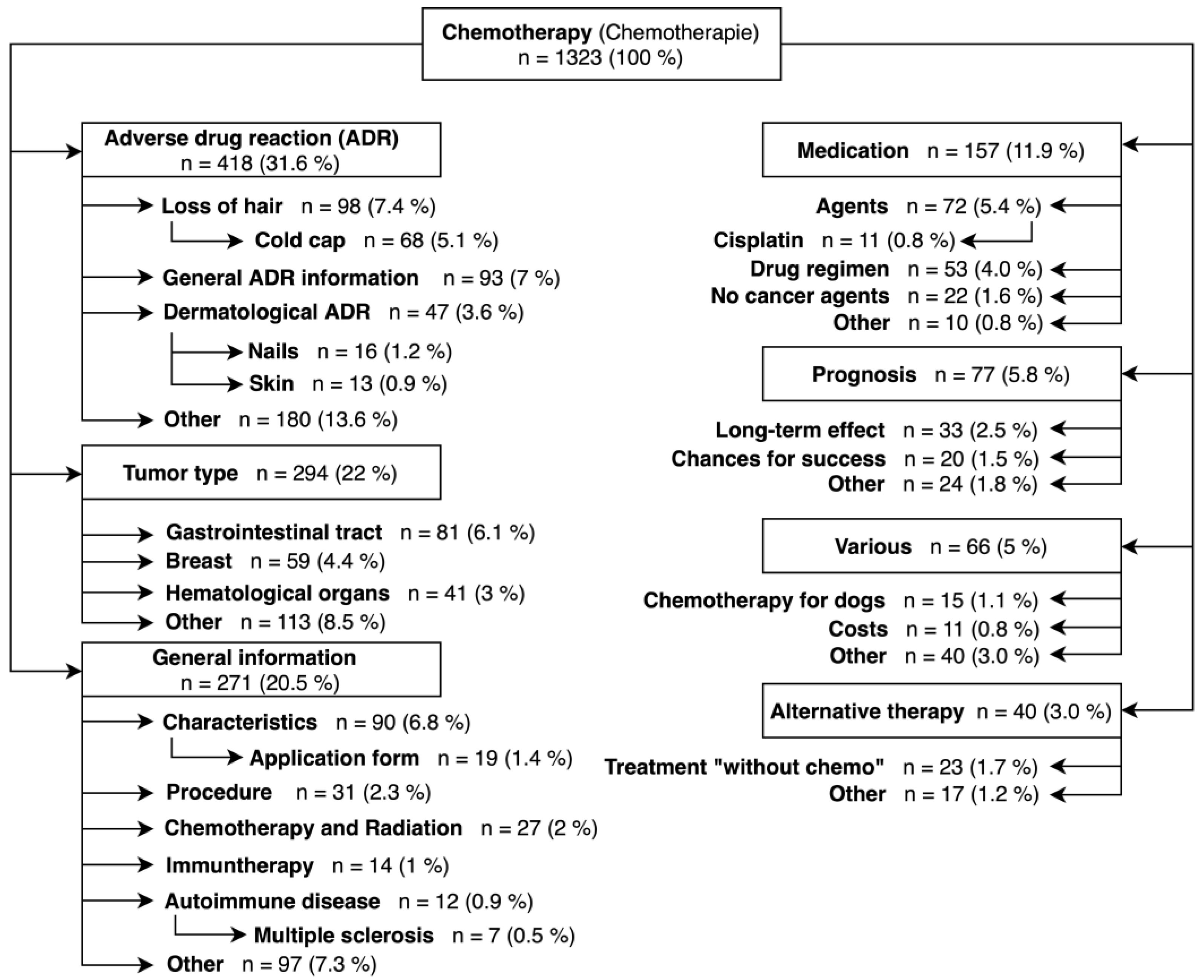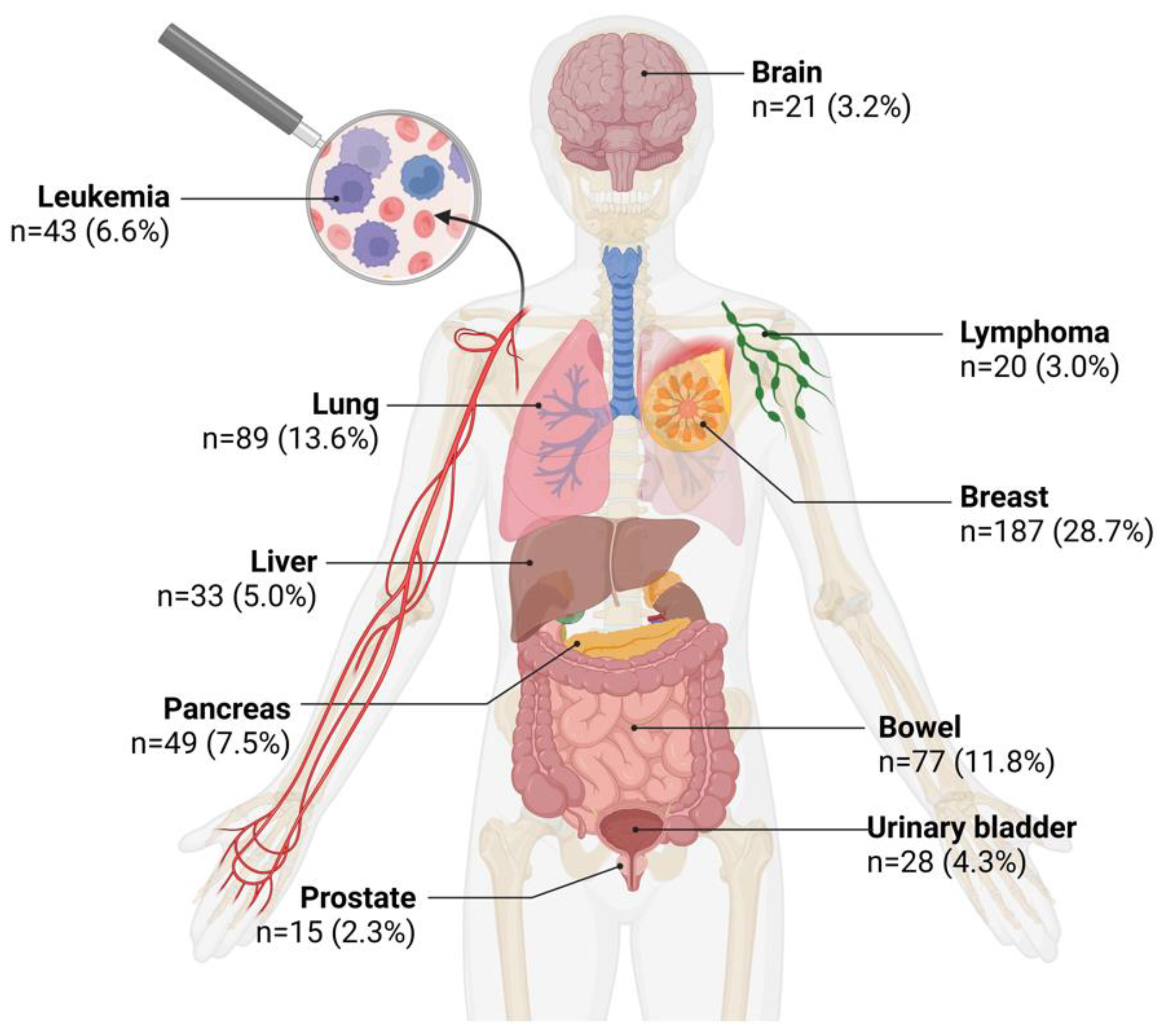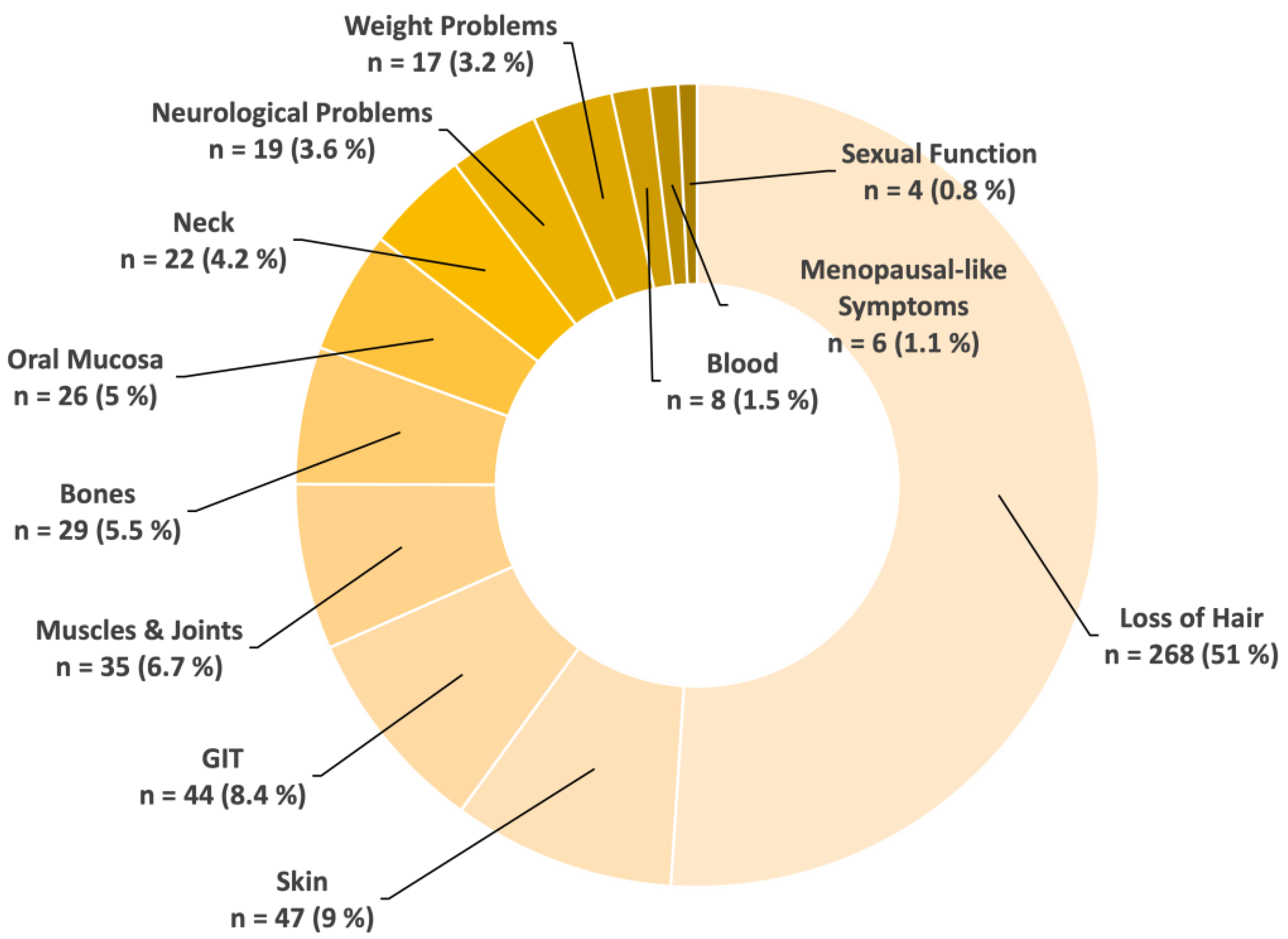Exploring the Thoughts, Needs and Fears of Chemotherapy Patients—An Analysis Based on Google Search Behavior
Abstract
:1. Introduction
2. Materials and Methods
2.1. Google AdWords
2.2. Google Trends
2.3. Statistical Analysis
3. Results
3.1. Chemotherapy Was Consistently Popular throughout the Investigation Period
3.2. General Information, Side Effects and Tumor Types Are Searched Most Frequently
3.3. The Specificity of the Search Terms Increases with Decreasing Search Frequency
3.4. The Most Frequently Searched Tumor Type Is Breast Cancer
3.5. Hair Loss Is by Far the Most Searched Side Effect of Chemotherapy
4. Discussion
5. Conclusions
Author Contributions
Funding
Institutional Review Board Statement
Informed Consent Statement
Data Availability Statement
Conflicts of Interest
References
- Lang-Rollin, I.; Berberich, G. Psycho-oncology. Dialogues Clin. Neurosci. 2018, 20, 13–22. [Google Scholar] [CrossRef] [PubMed]
- Hartzband, P.; Groopman, J. Untangling the Web—Patients, Doctors, and the Internet. N. Engl. J. Med. 2010, 362, 1063–1066. [Google Scholar] [CrossRef]
- Beck, F.; Richard, J.B.; Nguyen-Thanh, V.; Montagni, I.; Parizot, I.; Renahy, E. Use of the internet as a health information resource among French young adults: Results from a nationally representative survey. J. Med. Internet Res. 2014, 16, e128. [Google Scholar] [CrossRef]
- Bach, R.L.; Wenz, A. Studying health-related internet and mobile device use using web logs and smartphone records. PLoS ONE 2020, 15, e0234663. [Google Scholar] [CrossRef]
- Ebel, M.D.; Stellamanns, J.; Keinki, C.; Rudolph, I.; Huebner, J. Cancer Patients and the Internet: A Survey Among German Cancer Patients. J. Cancer Educ. 2017, 32, 503–508. [Google Scholar] [CrossRef]
- Foroughi, F.; Lam, A.K.Y.; Lim, M.S.C.; Saremi, N.; Ahmadvand, A. “Googling” for Cancer: An Infodemiological Assessment of Online Search Interests in Australia, Canada, New Zealand, the United Kingdom, and the United States. JMIR Cancer 2016, 2, e5. [Google Scholar] [CrossRef]
- Beisch, N.; Koch, W. Aktuelle Aspekte der Internetnutzung in Deutschland, ARD/ZDF-Onlinestudie: Vier von fünf Personen in Deutschland nutzen täglich das Internet [Current Aspects of Internet Usage in Germany, ARD/ZDF Online Study: Four out of five people in Germany use the Internet daily]. Media Perspekt. 2022, 10, 460–470. [Google Scholar]
- Lim, C.A.; Ingledew, P.A.; Yang, F.; Thiessen, B.; Cashman, R.; Lalani, N.; Kipfer, S. Analysis of Internet-Based Search Patterns Utilized by Glioma Patients as Information Source. J. Cancer Educ. 2022, 37, 1349–1356. [Google Scholar] [CrossRef] [PubMed]
- Seidl, S.; Schuster, B.; Rüth, M.; Biedermann, T.; Zink, A. What Do Germans Want to Know About Skin Cancer? A Nationwide Google Search Analysis From 2013 to 2017. J. Med. Internet Res. 2018, 20, e10327. [Google Scholar] [CrossRef]
- Scheerer, C.; Rüth, M.; Tizek, L.; Köberle, M.; Biedermann, T.; Zink, A. Googling for Ticks and Borreliosis in Germany: Nationwide Google Search Analysis From 2015 to 2018. J. Med. Internet Res. 2020, 22, e18581. [Google Scholar] [CrossRef]
- Tizek, L.; Schielein, M.; Rüth, M.; Ständer, S.; Pereira, M.P.; Eberlein, B.; Biedermann, T.; Zink, A. Influence of Climate on Google Internet Searches for Pruritus Across 16 German Cities: Retrospective Analysis. J. Med. Internet Res. 2019, 21, e13739. [Google Scholar] [CrossRef]
- Mick, A.; Tizek, L.; Schielein, M.; Zink, A. Can crowdsourced data help to optimize atopic dermatitis treatment? Comparing web search data and environmental data in Germany. J. Eur. Acad. Dermatol. Venereol. JEADV. 2022, 36, 557–565. [Google Scholar] [CrossRef] [PubMed]
- Mele, C. Is Wisconsin Really That Hard to Spell? The New York Times, 31 May 2017. Available online: https://www.nytimes.com/2017/05/31/us/misspelled-words-states.html (accessed on 1 August 2023).
- Wehner, M.R.; Nead, K.T.; Linos, E. Correlation Among Cancer Incidence and Mortality Rates and Internet Searches in the United States. JAMA Dermatol. 2017, 153, 911–914. [Google Scholar] [CrossRef]
- Eysenbach, G. Infodemiology and infoveillance: Framework for an emerging set of public health informatics methods to analyze search, communication and publication behavior on the Internet. J. Med. Internet Res. 2009, 11, e11. [Google Scholar] [CrossRef] [PubMed]
- Rabe, L. Suchmaschinen—Marktanteile Desktop-Und mobile Suche in Deutschland 2023 [Search Engines—Market Shares for Desktop and Mobile Searches in Germany 2023]. Available online: https://de.statista.com/statistik/daten/studie/301012/umfrage/marktanteile-der-suchmaschinen-und-marktanteile-mobile-suche/ (accessed on 3 April 2023).
- Eysenbach, G. Infodemiology and infoveillance tracking online health information and cyberbehavior for public health. Am. J. Prev. Med. [CrossRef]
- Kamiński, M.; Łoniewski, I.; Marlicz, W. “Dr. Google, I have a stomach ache”—Seasonal variations in abdominal pain: A 4-year retrospective data analysis from Google Ads keywords planner. Ther. Adv. Gastroenterol. 2020, 13, 1756284820931744. [Google Scholar] [CrossRef] [PubMed]
- Yamaguchi, Y.; Lee, D.; Nagai, T.; Funamoto, T.; Tajima, T.; Chosa, E. Googling Musculoskeletal-Related Pain and Ranking of Medical Associations’ Patient Information Pages: Google Ads Keyword Planner Analysis. J. Med. Internet Res. 2020, 22, e18684. [Google Scholar] [CrossRef]
- Zink, A.; Rüth, M.; Schuster, B.; Darsow, U.; Biedermann, T.; Ständer, S. Pruritus in Germany-a Google search engine analysis. Der Hautarzt 2019, 70, 21–28. [Google Scholar] [CrossRef]
- Pereira, M.P.; Ziehfreund, S.; Rueth, M.; Ewering, T.; Legat, F.J.; Lambert, J.; Elberling, J.; Misery, L.; Brenaut, E.; Papadavid, E.; et al. Google search trends for itch in Europe: A retrospective longitudinal study. J. Eur. Acad. Dermatol. Venereol. 2021, 35, 1362–1370. [Google Scholar] [CrossRef]
- Zink, A.; Schuster, B.; Rüth, M.; Pereira, M.P.; Philipp-Dormston, W.G.; Biedermann, T.; Ständer, S. Medical needs and major complaints related to pruritus in Germany: A 4-year retrospective analysis using Google AdWords Keyword Planner. J. Eur. Acad. Dermatol. Venereol. 2019, 33, 151–156. [Google Scholar] [CrossRef]
- Mavragani, A.; Ochoa, G. Google Trends in Infodemiology and Infoveillance: Methodology Framework. JMIR Public Health Surveill. 2019, 5, e13439. [Google Scholar] [CrossRef]
- Robert Koch Institut 2021. Krebs in Deutschland für 2017/2018. Krebs gesamt [Cancer in Germany for 2017/2018. Overall Cancer]. pp. 24–26. Available online: https://www.krebsdaten.de/Krebs/DE/Content/Publikationen/Krebs_in_Deutschland/kid_2021/krebs_in_deutschland_2021.pdf?__blob=publicationFile (accessed on 21 October 2023). [CrossRef]
- Statistisches Bundesamt Deutschland—GENESIS-Online [Federal Statistical Office of Germany—GENESIS-Online]. Published 21 October 2023. Available online: https://www-genesis.destatis.de/genesis/online?operation=abruftabelleBearbeiten&levelindex=1&levelid=1697917126100&auswahloperation=abruftabelleAuspraegungAuswaehlen&auswahlverzeichnis=ordnungsstruktur&auswahlziel=werteabruf&code=23211-0001&auswahltext=&werteabruf=Werteabruf#abreadcrumb (accessed on 21 October 2023).
- AlGhamdi, K.M.; Moussa, N.A. Internet use by the public to search for health-related information. Int. J. Med. Inf. 2012, 81, 363–373. [Google Scholar] [CrossRef]
- Zschorlich, B.; Gechter, D.; Janßen, I.M.; Swinehart, T.; Wiegard, B.; Koch, K. Health information on the Internet: Who is searching for what, when and how? Z. Evidenz Fortbild. Qual. Im. Gesundheitswesen. 2015, 109, 144–152. [Google Scholar] [CrossRef]
- Amante, D.J.; Hogan, T.P.; Pagoto, S.L.; English, T.M.; Lapane, K.L. Access to care and use of the Internet to search for health information: Results from the US National Health Interview Survey. J. Med. Internet Res. 2015, 17, e106. [Google Scholar] [CrossRef]
- Bidmon, S.; Terlutter, R. Gender Differences in Searching for Health Information on the Internet and the Virtual Patient-Physician Relationship in Germany: Exploratory Results on How Men and Women Differ and Why. J. Med. Internet Res. 2015, 17, e156. [Google Scholar] [CrossRef]
- Bansil, P.; Keenan, N.L.; Zlot, A.I.; Gilliland, J.C. Health-related Information on the Web: Results From the HealthStyles Survey, 2002–2003. Prev. Chronic Dis. 2006, 3, A36. [Google Scholar]
- Münstedt, K.; Manthey, N.; Sachsse, S.; Vahrson, H. Changes in self-concept and body image during alopecia induced cancer chemotherapy. Support. Care Cancer 1997, 5, 139–143. [Google Scholar] [CrossRef]





| Total Searches | n | Word Count per Search Term | |
|---|---|---|---|
| Group 1 | 10,000 to 1,000,000 | 2 | 1.5 ± 0.7 |
| Group 2 | 1000 to 10,000 | 15 | 2.3 ± 1.1 |
| Group 3 | 100 to 1000 | 121 | 2.6 ± 1.0 |
| Group 4 | 1 to 100 | 1.323 | 2.8 ± 0.8 |
| Keyword | Corresponding English Term | Group |
|---|---|---|
| Chemo Therapie | Chemotherapy | 1 |
| Chemotherapie | Chemotherapy | 1 |
| Adjuvant Chemotherapie | Adjuvant Chemotherapy | 2 |
| Adjuvante Chemotherapie | Adjuvant Chemotherapy | 2 |
| Adjuvanten Chemotherapie | Adjuvant Chemotherapy | 2 |
| Chemo Nebenwirkungen | Side effects of Chemotherapy | 2 |
| Chemotherapie Ablauf | Chemotherapy regime | 2 |
| Chemotherapie Erfolgsquote | Success rate of Chemotherapies | 2 |
| Chemotherapie Nebenwirkungen | Side effects of Chemotherapy | 2 |
| FOLFIRINOX | FOLFIRINOX | 2 |
| Nebenwirkungen Chemotherapie | Side effects of Chemotherapy | 2 |
| Neoadjuvant Chemotherapie | Neoadjuvant Chemotherapy | 2 |
| Neoadjuvante Chemotherapie | Neoadjuvant Chemotherapy | 2 |
| Neoadjuvanten Chemotherapie | Neoadjuvant Chemotherapy | 2 |
| Palliative Chemotherapie | Palliative Chemotherapy | 2 |
| Welche Chemo ist am schlimmsten | What is the toughest Chemotherapy | 2 |
| Welche Chemo ist die stärkste | What is the strongest Chemotherapy | 2 |
Disclaimer/Publisher’s Note: The statements, opinions and data contained in all publications are solely those of the individual author(s) and contributor(s) and not of MDPI and/or the editor(s). MDPI and/or the editor(s) disclaim responsibility for any injury to people or property resulting from any ideas, methods, instructions or products referred to in the content. |
© 2024 by the authors. Licensee MDPI, Basel, Switzerland. This article is an open access article distributed under the terms and conditions of the Creative Commons Attribution (CC BY) license (https://creativecommons.org/licenses/by/4.0/).
Share and Cite
Özistanbullu, D.; Weber, R.; Schröder, M.; Kippenberger, S.; Kleemann, J.; Stege, H.; Kaufmann, R.; Schilling, B.; Grabbe, S.; Wilhelm, R. Exploring the Thoughts, Needs and Fears of Chemotherapy Patients—An Analysis Based on Google Search Behavior. Healthcare 2024, 12, 1689. https://doi.org/10.3390/healthcare12171689
Özistanbullu D, Weber R, Schröder M, Kippenberger S, Kleemann J, Stege H, Kaufmann R, Schilling B, Grabbe S, Wilhelm R. Exploring the Thoughts, Needs and Fears of Chemotherapy Patients—An Analysis Based on Google Search Behavior. Healthcare. 2024; 12(17):1689. https://doi.org/10.3390/healthcare12171689
Chicago/Turabian StyleÖzistanbullu, Deniz, Ronja Weber, Maria Schröder, Stefan Kippenberger, Johannes Kleemann, Henner Stege, Roland Kaufmann, Bastian Schilling, Stephan Grabbe, and Raphael Wilhelm. 2024. "Exploring the Thoughts, Needs and Fears of Chemotherapy Patients—An Analysis Based on Google Search Behavior" Healthcare 12, no. 17: 1689. https://doi.org/10.3390/healthcare12171689
APA StyleÖzistanbullu, D., Weber, R., Schröder, M., Kippenberger, S., Kleemann, J., Stege, H., Kaufmann, R., Schilling, B., Grabbe, S., & Wilhelm, R. (2024). Exploring the Thoughts, Needs and Fears of Chemotherapy Patients—An Analysis Based on Google Search Behavior. Healthcare, 12(17), 1689. https://doi.org/10.3390/healthcare12171689








